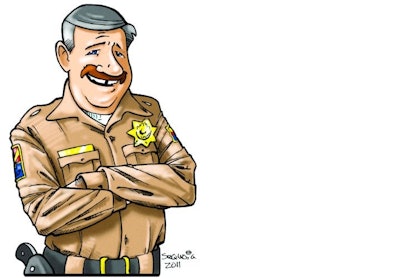 Illustration: Sequoia Blankenship
Illustration: Sequoia Blankenship
The trend of ambushing officers has not seemed to abate (although most of the media's overheated rhetoric has) and the abundance of body and dash cameras has given us an edge on seeing how officers have overcome such assaults. Often these attacks are so sudden and violent the officer's doom seems certain, yet they manage to overcome the bushwhacking…but how?
We often see our heroes ignite that inner fire, that power that lies deep within. Hank Hayes calls it "fighting like a raccoon in a dumpster!" And that is a metaphor that really captures the essence of the spirit we see in officers in these desperate engagements. There is a moment during that initial combat where an officer who is less trained or mentally prepared might panic, yet instead we see an explosive response that signals that training and mindset have kicked in and the fight is in full swing.
Panic is a deadly enemy, and scientists tell us that it is the coming together of three simultaneous mental states: I am alone; I have nowhere to run; I cannot handle this. Even though the officer may be in a crowd, have great cover options, and be trained for other conflicts, the panicked mental state can occur. The certain antidotes for panic are good old fashioned training, a faith in or a sense of mission (you must do this, no one else can), and courage. Teddy Roosevelt tells us, "Courage is not having the strength to go on; it is going on when you don't have the strength." Remember, you are not alone, there is always something else you can try, and you can handle it; panic, in the end, is an illusion that courage dispels.
While we do see panicked officers from time to time, most often we see them fighting back; how effectively they do so is dependent on some variables that need to be addressed, and hopefully all of you reading this will take time to do a self-assessment.
First, what is the officer's situational awareness? Has the officer taken to time to look for additional threats, cover options, threat cues, and environmental hazards? If so, this is a sure sign that our warrior is in "Condition Yellow: broad external awareness." This process creates an anticipatory mindset; the famous "When/Then!" thought process that the great Chuck Remsburg called "preparation not paranoia!" This is a preloading for action which shortens reaction time, and has the mind already analyzing responses; call it a tightening of our "OODA Loop." If the videos of our brothers and sisters fighting for their lives have done anything they should have given us the sense of spontaneous combustion that occurs in these life and death moments; something that for some reason the media, the courts, and too many of our own fail to appreciate. The situation is always preceded by ambiguity, doubt, and fear, and if disbelief is added it can greatly retard our ability to act rapidly and effectively.
Secondly, we see successful officers, even wounded ones, continuing to fight. Too often we teach a sort of "bang bang, you're dead" mindset, stopping action immediately after shooting the trainee in a scenario instead of making the officer fight his or her way out of the event. The vast majority of people shot survive, but not if they just lie there. The old saying "you're not dead till your dead" means exactly that; don't write yourself off just because you are wounded. Win the fight and start self-aid if you don't have anyone around to give you buddy aid. General Hal Moore said, "There's always one more thing you can do to influence any situation in your favor—and after that one more thing, and after that…. The more you do the more opportunities arise." Take this to heart, and always stay in the fight.
Finally, mentally rehearse every video you see, and ask yourself what you would do. The marvelous ability of the human mind to preprogram an event, long before it ever happens, has always been part of the effective warrior's skill. Visualizing yourself winning in all sorts of ambushes inoculates you against panic, preloads you for victory, and shortens your response time, so "just do it!"
OK, OK, I know what you are thinking: "Man, this column is full of sayings and quotes; I already know all of these!" Exactly, my brothers and sisters. Wisdom can often be boiled down to short homilies and sayings, and we begin to take these for granted; but those of you walking the warrior's path should take time to reflect on these gems. Remember the Chinese curse "May you live in interesting times?" We do, and we need all the wisdom we can find to inspire us to persevere; so here's one more quote:
"Never give in, never give in, never, never, never, never—in nothing, great or small, large or petty—never give in except to convictions of honor and good sense." —Winston Churchill
Dave Smith is an internationally recognized law enforcement trainer and is the creator of "JD Buck Savage." You can follow Buck on Twitter at @thebucksavage.












